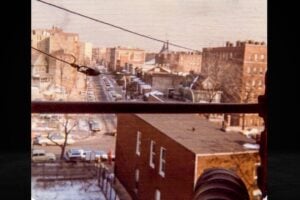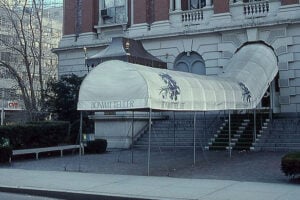
Photo: “The Dakota” by V Manninen is licensed under CC BY 2.0
The Dakota Building: New York’s Most Exclusive Address article takes a look back at the history of New York’s Dakota Building.
The Dakota building, located at 72nd Street and Central Park West is a blend of Renaissance modern, gothic, and Victorian architecture, which makes it one of New York’s historical treasures. Commissioned by Edward Clark, of the Singer Sewing Machine dynasty, the Dakota was designed by Architect Henry Janeway Hardenbergh. The Dakota Apartments (as it was then known) took four years to build and opened its doors to renters back in 1884.
Origins Of The Building’s Name
There is a debate as to the reason for its name—some say Central Park West was once as deserted as the plains, and others argue that it’s so named for its northwest location. The statue of a regal Native American graces the 72nd Street entrance, so despite the overall design, an artistic nod to the American West was included. It’s the mysterious details and painstaking touches that make the Dakota stand out against other buildings gracing the New York skyline.

Photo: Gary Blakeley/ Shutterstock
Central Courtyard Entryway
One of the most iconic features of the Dakota building is the huge central courtyard entryway, designed wide so that horses and buggies could do a quick turnaround when picking up or dropping off guests. It’s that historical detail that served a practical purpose that makes The Dakota a one of a kind landmark. Tennis courts, 24-hour doormen, and concierge service add to the building’s opulent appeal.

Photo: MarinaMonroe/Shutterstock
Dakota Building Exterior
The outside of the Dakota, with its spires, turrets, and gargoyles, made it a natural choice to use in the 1967 horror classic Rosemary’s Baby, as a stand-in for the spooky Bramford Apartments, described in Ira Levin’s novel of the same name. Using the Dakota for Bramford’s exterior shots was sheer genius. As the opening credits roll, the camera artfully pans over the gothic spires, creating a sense of foreboding even before the story unfolds.
“The Bramford” was as much a star of the film as Mia Farrow; however, the interior shots were filmed off-site. Mia’s character, Rosemary, is warned by her friend, Hutch, that the building has a terrible history of death and black magic. The architecture of the Dakota lends one to believe that if a New York building was home to macabre happening, this would be the one. Another psychological thriller, Vanilla Sky, had the protagonist David Aames, living at the Dakota, owning not one, but two apartments at that exclusive address.
Famous Tenants
Renown as the place where songwriter, musician, and former Beatle John Lennon was brutally murdered, the Dakota has long been a sought-after address for the rich and famous and has been home to celebrity icons Lauren Bacall, Leonard Bernstein, Roberta Flack, and Boris Karloff, among others. A few years ago, Ms. Bacall’s 10-room apartment sold for 14.5 million dollars. Each apartment is uniquely designed, however, the main living areas of each unit all command spectacular cityscape views. The kitchen and other ancillary rooms face the palatial courtyard.

Photo: Lauren Bacall , Public domain, via Wikimedia Commons
The Exclusive Issues
Despite the number of past and present celebrity residents, not everyone can live the Dakota lifestyle. No matter how much money a celebrity has, the Dakota’s finicky co-op board has turned away many a megastar for unknown reasons. Billy Joel and Gene Simmons could not move in, nor could Melanie Griffith, although she has a famous daughter named Dakota.
Why do some get it and others don’t? Critics have cited racism, sexism, and arbitrary random discrimination for reasons the co-op board is so choosy. A potential buyer can be rejected for the type of dog they own or an ill-timed tabloid rumor. The co-op board is now facing challenges from folks who are calling “foul” on their selection process. Whatever the reason for putting the kibosh on applications, part of the appeal to some is that it is so country club selective. It seems absurd that a New York address would be kept out of reach of those who could afford the entire square footage of the Dakota building at a slightly less posh New York address, but that is how it is.
It wasn’t always that way—before the Dakota went co-op in the 1960s, just about anyone who could afford the rent (moderate by today’s NYC rental prices) would be welcome to rent an apartment, if one was up for vacancy. Although it housed many well-heeled families like the Steinways, several working professionals also shared the building. The private serving staff was housed with the maintenance staff upstairs in the peaks. What was once primarily housing space, now includes music studios, gourmet kitchens, and private office space for celebrities who want to work from home.
The Dakota: A New York Landmark
Due to its prestige and one of a kind style, the Dakota was added to the New York Registry of Landmarks in 1969 and in 1976 it was declared a National Landmark. The front side of the building has undergone some needed restoration in recent years, but the building itself stands proud as a vision of 1800s New York amid a modern bustling metropolis.
Tourists arriving in New York often take in The Dakota as one of the must-see sights in the city. Before and after Lennon’s death in 1980, sight seekers with cameras flocking the street outside has always been part of daily life at The Dakota. Although there are still plenty of celebrities coming and going from the Dakota, Beatles fans still leave flowers and tributes at the gates for one treasured rock star who will never again stop on his way to sign autographs. Strawberry Fields is just across the street in Central Park where fans also pay tribute to John Lennon.
Dakota Ghost Stories
Considering all of the famous residents who have lived at this square-shaped exclusive address, ghost stories have been a part of the Dakota’s legend and lore. John Lennon is included as one of the famous ghosts who claimed to still watch over loved ones at the Dakota; however, spirit apparitions have been part of the Dakota’s story, practically since it opened its doors. Most of the stories, however, come from “investigators” who have never been closer than the sidewalk to the historical Manhattan building, as curiosity seekers, paranormal or otherwise, are not admitted to roam the Dakota. Still, with the difficulty in getting into the Dakota, some may not want to depart New York’s most singularly gorgeous residential landmark. There is something about the majestic architecture, 14-foot ceilings, scenic views, and carefully constructed room designs that make the Dakota a swank building that no one would ever want to leave.

Feature Photo: Massimo Salesi / Shutterstock.com
The Dakota Building: New York’s Most Exclusive Address article published on ClassicNewYorkHistory.com ©2023
ClassicNewYorkHistory.com claims ownership of all its original content and Intellectual property under United States Copyright laws and those of all other foreign countries. No one person, business, or organization is allowed to re-publish any of our original content anywhere on the web or in print without our permission. All photos used in the articles are either original photographs taken by ClassicNewYorkHistory.com journalists, public domain creative commons photos or photos licensed officially from Shutterstock under license with ClassicNewYorkHistory.com and ClassicRockHistory.com. All photo credits have been placed at end of the article.




























